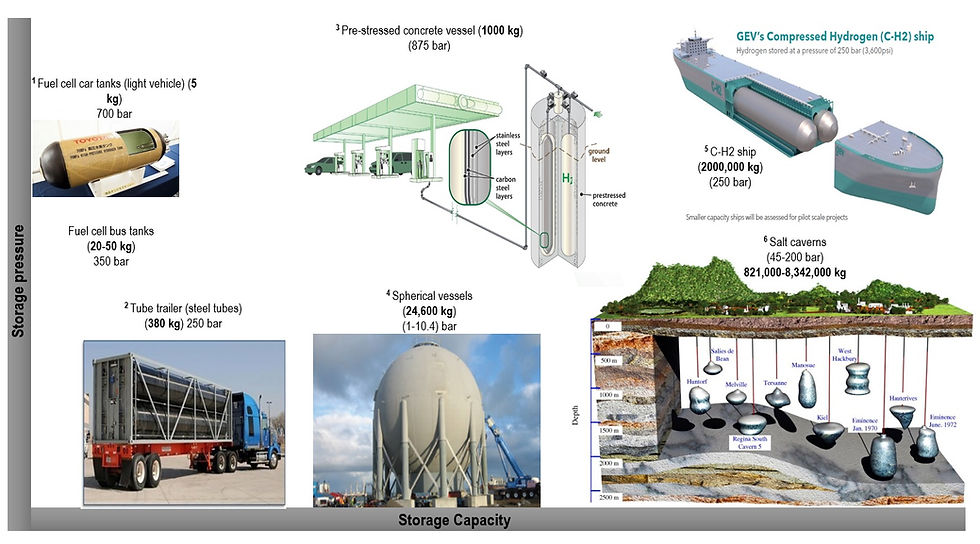
The significant consumption of fossil fuels in the past few decades had detrimental impacts on climate change and there is an urgent need for transition towards renewable and sustainable energy resources. Hydrogen has emerged as an excellent energy carrier to assist in decarbonizing fossil-fuel based economies particularly in transportation sector and heavy industry. Hydrogen is the most abundant element in the universe and has a gravimetric energy density of 120 MJ/kg that is almost 3 times more than diesel (in electrical terms, hydrogen has energy density of 33.3 kWh/kg versus about 12 kWh/kg for diesel). However hydrogen has a low volumetric energy density and hence requires storage at high pressures for transportation.
Hydrogen can be produced by water splitting (electrolysis of water) and if electricity is supplied from renewable resources (e.g. wind and solar) then it will have a very small carbon footprint. This is named Green hydrogen. Hydrogen can also be produced from fossil fuels by steam methane reforming (SMR) or coal gasification at much larger scales (200-400 ton/day), however these methods emit carbon dioxide that needs to be captured and stored. They are called Blue and Brown hydrogen respectively.
Figure.1 summarizes storage capacity and storage pressure for a number of storage (physical) options.

Hydrogen density (0.08988 kg/m3 STP) is about 7 times less than natural gas (0.717 kg/m3 STP) so more energy is required to compress same amount of hydrogen (in mass basis) compared to natural gas. For example, in large scale storage of hydrogen, to increase hydrogen pressure from 30 bar (outlet pressure of a PEM electrolyzer) to 200 bar (typical pressure for storage in underground caverns/depleted reservoirs) at a rate of 1.5 ton/hr, a compressor with a total electric load of approximately 1.29 MW is needed. For natural gas, a compressor with an electrical load of just 0.147 MW can do the same job! (1.29 MW is equal to 259 solar roof top systems with nameplate capacity of 5 kW).
STP: Standard temperature and pressure is defined as 0 ⁰C and 1 atm.
Underground hydrogen storage (UHS) is a critical element in hydrogen supply chain and this becomes even more important when seasonal variation in renewable energy interrupts the supply of green hydrogen. Underground storage at large scales potentially helps in decarbonizing carbon-intensive industries such as steel production. Currently, underground storage in salt caverns is commercially operated mostly in Europe and US. Storage capacity of currently operating salt caverns range from 821-8342 ton(7). Salt caverns are good candidates for UHS because they are impermeable, however this option is restricted to geographical locations where suitable salt formations can be found to leach caverns.
Hydrogen storage in depleted gas reservoirs is also an option for storage of hydrogen at large scales. Currently natural gas is commercially stored in depleted gas fields and it is expected that hydrogen can also be stored in the same way. While large amount of hydrogen can be theoretically stored in depleted gas reservoirs there are a number of technical difficulties that need to be carefully investigated in each storage site including cushion gas requirement, seal capacity of overlying rocks, geo-chemical and biological activities, maximum withdrawal rates, and compression/purification requirements. In the next post, I will go through these technical challenges for storage of hydrogen in depleted gas reservoirs.
References:
3 Feng, Z. (2015). Steel Concrete Composite Vessel for 875 bar Stationary Hydrogen Storage. Retrieved from https://www.google.com/url?sa=t&rct=j&q=&esrc=s&source=web&cd=&ved=2ahUKEwjFydDKiK_xAhXlxTgGHXGGDrwQFjACegQIBRAD&url=https%3A%2F%2Fwww.hydrogen.energy.gov%2Fpdfs%2Freview15%2Fpd109_feng_2015_o.pdf&usg=AOvVaw0QSmPA8zh9tnWaGsIhF7Ax
6 K.W. John, Evaporites: Sediments, Resources and Hydrocarbons, Springer (2006)
7 Groenenberg, R. M., Juez-Larre, J., Goncalvez, C., Wasch, L. J., Dijkstra, H. E., Wassing, B. B. T., . . . Kranenburg-Bruinsma, K. J. (2020). Techno-Economic Modelling of Large-Scale Energy Storage Systems. Retrieved from http://resolver.tudelft.nl/uuid:e707e44d-46c4-4bcd-90d8-f93ee91b2d49


Comments